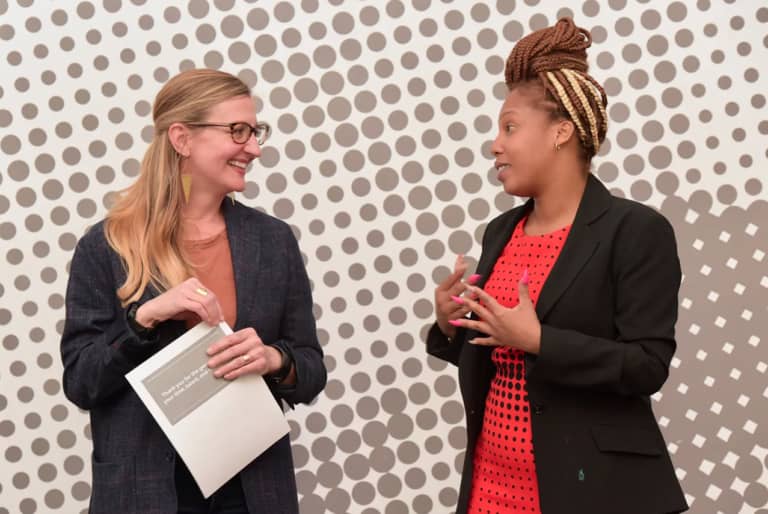Rebekah Moore and Aziza Robinson-Goodnight never expected to be presenting in front of a crowd at the American Public Health Association’s annual expo. But that’s exactly where they found themselves this year, as they presented their latest research to a packed room of public health experts.
Moore is an ethnomusicologist and assistant professor of music at Northeastern University; Robinson-Goodnight is a renowned artist, activist, entrepreneur and organizer. Together, the two are also co-leads of a new Northeastern research project that aims to link the arts and public health in an attempt to tackle racial and health inequities. They say artists are more than creators. They’re essential workers, valuable community resources that can improve public health in Boston and beyond, particularly in communities of color.
“We’re actually looking at the arts as preventative care, something that we can actually start seeing some results [from] fairly soon in terms of behavioral health outcomes, behavioral change,” Moore says. “[We] are very committed to the idea that everything gets better when community gets stronger, so we need to focus on what is creating unease in Boston communities. That’s where our focus should be and what role do artists have in addressing that.”
The project was spawned by a creative collaboration between Moore and Shan Mohammed, a clinical professor in the Bouvé College of Health Sciences and founding director of the master of public health program at Northeastern. Mohammed shared Moore’s interest in spotlighting the role the arts could play in public health, not theoretically but practically.
“If you look at the variety of health issues that we haven’t solved that are complex–chronic disease, substance misuse, mental health issues, infectious diseases–anything where we’re trying to change policy and change health behaviors, artists have such a critical role to play,” Mohammed says.

Moore and Robinson-Goodnight hope to expand their project to include collaborative focus groups with artists and community health center leaders. They hope to spark conversations and connections that can lead to new ways of thinking about the link between the arts and public health. Photos by Vania Arroyo
In 2020, Moore applied for a Tier 1 grant, which is designed to fund interdisciplinary research, with the largest team that has ever applied for such a grant at Northeastern. It included seven faculty and two staff spread across four colleges. There was excitement and energy behind the project. Then, COVID-19 hit.
“These questions became so much more frighteningly relevant because we saw in real time what it means for racism to lead people to die,” Moore says.
That year, Moore brought on Robinson-Goodnight, who serves as lead co-investigator on the project, to help embed the project in the community. Robinson-Goodnight came with not only strong community ties but a deep awareness and knowledge of what art can do for a community.
“It’s my life,” Robinson-Goodnight says of the project’s mission. And she means that literally.
Her father is world-renowned artist Paul Goodnight, and she grew up in the Piano Factory, a historic artist community in Boston that served as the inspiration for the musical “Rent” and still provides gallery and living space for artists today. The Factory was a hub for Black artists, and it maintains a legendary status in the community.
“With all of those various puzzle pieces, now we’re trying to put them all together into a narrative that makes sense for public health workers, government stakeholders, artists and community activists”
As part of the research, Moore and Robinson-Goodnight have conducted 30 interviews––more than 40 hours of conversations–with Black, Latinx, Asian and indigenous artists in Boston neighborhoods like the South End, Roxbury, Jamaica Plain and Dorchester. They talked with them about how they define the health of their community and how they envision their roles in public health. Throughout the interviews, artists also talked about the challenges they face working in Boston: the lack of artist housing and arts education, the high cost of studio space and the racism they have experienced from venues. These barriers result in measurable consequences for artists and, in turn, the community as a whole.
“If you cannot feel like you are valued, that’s when mental health issues arrive,” Robinson-Goodnight says. “But also when thinking about schools and children–and this is what we’re proving––having art and creativity at the core allows for brain expansion, allows for trauma release. It allows for all the things that people need, not just young people, to actually get through the times that we’re in, the times we’ve always been in.”
Addressing those challenges requires systemic, political and cultural change, starting at the community level. Thanks to the PEAK Experiences Award student research Jordan Rhyner received this year, the researchers are looking to conduct focus groups with artists and health center leaders. As part of his capstone, Rhyner will also be taking the lead on writing a research paper that will spread their work to city leaders, researchers at other universities and community organizers.
“With all of those various puzzle pieces, now we’re trying to put them all together into a narrative that makes sense for public health workers, government stakeholders, artists and community activists,” Moore says.
The hope is that these conversations will spark collaboration that could lead to more awareness about the value of the arts and, ultimately, programs and policy.
“Changing the image, changing the whole value system around what the contribution of artists is [and] what they bring to society would create a huge shift in how artists are integrated into different parts of professional life and social life,” Robinson-Goodnight says.
This post was originally published on News @ Northeastern by Cody Mello-Klein.




